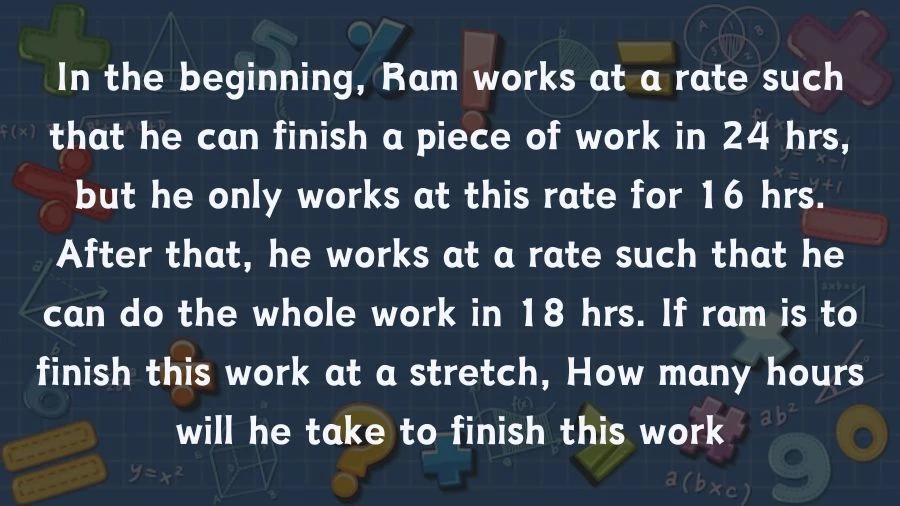If you happen to be viewing the article In the beginning, Ram works at a rate such that he can finish a piece of work in 24 hrs, but he only works at this rate for 16 hrs. After that, he works at a rate such that he can do the whole work in 18 hrs. If ram is to finish this work at a stretch, How many hours will he take to finish this work? ? on the website Math Hello Kitty, there are a couple of convenient ways for you to navigate through the content. You have the option to simply scroll down and leisurely read each section at your own pace. Alternatively, if you’re in a rush or looking for specific information, you can swiftly click on the table of contents provided. This will instantly direct you to the exact section that contains the information you need most urgently.
In the beginning, Ram works at a rate such that he can finish a piece of work in 24 hrs, but he only works at this rate for 16 hrs. After that, he works at a rate such that he can do the whole work in 18 hrs. If ram is to finish this work at a stretch, How many hours will he take to finish this work?
Ram will take 22 hrs to finish the work.
Here’s how :
Let’s denote the rate at which Ram works in the first 16 hours as R1 (where he can finish the work in 24 hours) and the rate at which he works after the initial 16 hours as R2 (where he can finish the work in 18 hours).
Article continues below advertisement
Let W be the total amount of work.
In the first 16 hours, Ram completes 16. R1 amount of work.
In the remaining time (after the first 16 hours), Ram completes the rest of the work using the rate R2, and this takes T hours.
So, the work completed in the remaining time is T⋅R2.
The total work is equal to the sum of the work done in the first 16 hours and the work done in the remaining time:
16⋅R1+T⋅R2=W
Now, we know that Ram can finish the whole work at a rate of R2 in 18 hours. Therefore,
R2 = W/18.
Substitute R2 in the equation:
16⋅R1+T⋅W/18 = W
Now, we are given that Ram can finish the work at a rate R1 in 24 hours. Therefore,
R1 = W/24.
Substitute R1 in the equation:
16⋅W/24 + T⋅W/18 = W
Now, solve for T:
2/3 + T/18 =1
T/18 = 1/3
T=6
So, Ram will take 6 hours to finish the remaining work after the initial 16 hours.
Therefore, the total time Ram will take to finish the work at a stretch is 16+6 = 22 hours.
Algebra and Linear Equations
Algebra and linear equations are fundamental concepts in mathematics that are used to represent and solve problems involving unknown quantities.
Algebra is a branch of mathematics that deals with the manipulation of symbols and expressions to represent and solve equations and inequalities. It provides a powerful language for modeling and analyzing quantitative relationships.
Article continues below advertisement
Article continues below advertisement
Linear equations are a specific type of algebraic equation in which the highest power of any variable is 1. They are often written in the form ax + b = 0, where a and b are constants and x is the unknown variable. The graph of a linear equation is always a straight line.
Here are some key features of linear equations:
- Degree: The highest power of any variable in the equation is 1.
- Standard form: The equation can be written in the form ax + b = 0, where a and b are constants and x is the unknown variable.
- Slope-intercept form: The equation can be written in the form y = mx + b, where m is the slope of the line and b is the y-intercept (the point where the line crosses the y-axis).
- Solutions: A linear equation can have one solution, no solutions, or infinitely many solutions.
Linear equations have a wide range of applications in various fields, including:
- Physics: Modeling motion, forces, and other physical phenomena.
- Chemistry: Balancing chemical equations and calculating concentrations.
- Economics: Modeling supply and demand, market equilibrium, and other economic relationships.
- Computer science: Developing algorithms and solving computational problems.
Here are some examples of linear equations:
- 2x + 3 = 5 (This equation has one solution, x = 1.)
- 3x – y = 6 (This equation has infinitely many solutions, which can be expressed as y = 3x + 6.)
- x + 2 = 0 (This equation has no solutions.)
Thank you so much for taking the time to read the article titled In the beginning, Ram works at a rate such that he can finish a piece of work in 24 hrs, but he only works at this rate for 16 hrs. After that, he works at a rate such that he can do the whole work in 18 hrs. If ram is to finish this work at a stretch, How many hours will he take to finish this work? written by Math Hello Kitty. Your support means a lot to us! We are glad that you found this article useful. If you have any feedback or thoughts, we would love to hear from you. Don’t forget to leave a comment and review on our website to help introduce it to others. Once again, we sincerely appreciate your support and thank you for being a valued reader!
Source: Math Hello Kitty
Categories: Math

